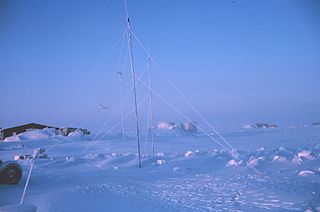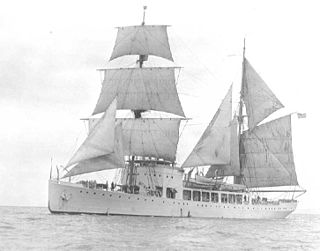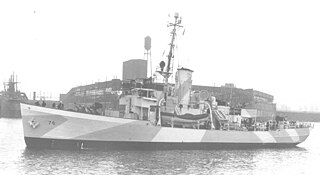
Pituffik Space Base, formerly Thule Air Base, is the United States Space Force's northernmost base, and the northernmost installation of the U.S. Armed Forces, located 750 mi (1,210 km) north of the Arctic Circle and 947 mi (1,524 km) from the North Pole on the northwest coast of the island of Greenland. Pituffik's Arctic environment includes icebergs in North Star Bay, two islands, a polar ice sheet, and Wolstenholme Fjord – the only place on Earth where four active glaciers join. The base is home to a substantial portion of the global network of missile warning sensors of Space Delta 4, and space surveillance and space control sensors of Space Delta 2, providing space awareness and advanced missile detection capabilities to North American Aerospace Defense Command (NORAD), the United States Space Force, and joint partners.

Bernt Balchen was a Norwegian pioneer polar aviator, navigator, aircraft mechanical engineer and military leader. A Norwegian native, he later became an American citizen and was a recipient of the Distinguished Flying Cross.

Station Nord is a military and scientific station in northeastern Greenland 1700 km north of the Arctic Circle.

Bluie West One, later known as Narsarsuaq Air Base and Narsarsuaq Airport, was built on a glacial moraine at what is now the village of Narsarsuaq, near the southern tip of Greenland. Construction by the United States Army began in June 1941. The first aircraft landed there in January 1942, as a link in the North Atlantic air ferry route in World War II. The base had a peak population of about 4,000 American servicemen, and it is estimated that some 10,000 aircraft landed there en route to the war in Europe and North Africa.

Iqaluit Airport serves Iqaluit, Nunavut, Canada and is located adjacent to the city. It hosts scheduled passenger service from Ottawa, Montreal, Rankin Inlet, and Kuujjuaq on carriers such as Canadian North, and from smaller communities throughout eastern Nunavut. It is also used as a forward operating base by the Royal Canadian Air Force (RCAF). In 2011, the terminal handled more than 120,000 passengers.
The Crimson Route was a set of joint United States and Canada transport routes planned for ferrying planes and material from North America to Europe during World War II. The project was ended in 1943 and never fully developed.

The Kee Bird was a United States Army Air Forces Boeing B-29 Superfortress, serial 45-21768, of the 46th Reconnaissance Squadron, that became marooned after making an emergency landing in northwest Greenland during a secret Cold War spying mission on 21 February 1947. While the entire crew was safely evacuated after spending three days in the isolated Arctic tundra, the aircraft itself was left at the landing site. It lay there undisturbed until 1994, when a privately funded mission was launched to repair and return it. During the attempted recovery, a fire broke out, resulting in the destruction and loss of the airframe on the ground.

The fall of Denmark in April 1940 left the Danish colony of Greenland an unoccupied territory of an occupied nation, under the possibility of seizure by the United Kingdom, United States or Canada. To forestall this, the United States acted to guarantee Greenland's position. With the entrance of the United States into the war in December 1941, Greenland became a combatant.

Sondrestrom Air Base, originally Bluie West-8, was a United States Air Force base in central Greenland. The site is located 60 mi (97 km) north of the Arctic Circle and 90 mi (140 km) from the northeast end of Kangerlussuaq Fjord. The base is approximately 11 mi (18 km) west-northwest of Ravneklippen and 80 mi (130 km) east of Sisimiut.

USCGC Northland (WPG-49) was a United States Coast Guard cruising class of gunboat especially designed for Arctic operations in commission from 1927 to 1938 and from 1939 to 1946. She served during World War II. She was the last cruising cutter built for the Coast Guard equipped with a sailing rig.

Northeast Air Command (NEAC) was a Major Command of the United States Air Force, responsible for the operation and defense of air bases in Greenland, Labrador, and Newfoundland. It was formed in 1950 from the facilities of the United States established during World War II in eastern Canada, Newfoundland and Greenland. It was discontinued in 1957.

Bluie was the United States military code name for Greenland during World War II. It is remembered by the numbered sequence of base locations identified by the 1941 United States Coast Guard South Greenland Survey Expedition, and subsequently used in radio communications by airmen unfamiliar with pronunciation of the Greenlandic Inuit and Danish names of those locations. These were typically spoken BLUIE (direction) (number), with direction being east or west along the Greenland coast from Cape Farewell.

The North Atlantic air ferry route was a series of Air Routes over the North Atlantic Ocean on which aircraft were ferried from the United States and Canada to Great Britain during World War II to support combat operations in the European Theater of Operations (ETO).

USCGC Comanche (WPG-76) was a United States Coast Guard cutter built by Pusey & Jones Corporation, Wilmington, Delaware, and launched 6 September 1934. She was commissioned on 1 December 1934. She was used extensively during World War II for convoy operations to Greenland and as a part of the Greenland Patrol.
Marrak Point was the location and common name for a minor United States Army Air Forces airfield on the west coast of Greenland. It was operational from 1942 to 1945.
DYE Stations were Distant Early Warning Line sites of the DEW Line eastern extension in Arctic North America in Greenland and Iceland. DYE Stations were equipped with the 600 MHz AN/FPS-30 long-range radar within geodesic domes of about 60 feet diameter. Crews were regularly supplied and rotated by C-130 aircraft of the 109th Airlift Wing (NYANG) staging through Sondrestrom Air Base.
Simiutaq, old spelling Simiutak, is an uninhabited island in the Kujalleq municipality in southwestern Greenland. During the Second World War and after Simiutak was the site of a U.S. Navy facility code-named 'Bluie West 3'.

The USCGC North Star was a United States Coast Guard Cutter during the Second World War. It was originally built for the U.S. Interior Department and served in the United States Coast Guard (USCG) before being acquired by the U.S. Navy.

The Greenland Patrol was a United States Coast Guard operation during World War II. The patrol was formed to support the U.S. Army building aerodrome facilities in Greenland for ferrying aircraft to the British Isles, and to defend Greenland with special attention to preventing German operations in the northeast. Coast Guard cutters were assisted by aircraft and dog sled teams patrolling the Greenland coast for Axis military activities. The patrol escorted Allied shipping to and from Greenland, built navigation and communication facilities, and provided rescue and weather ship services in the area from 1941 through 1945.

















